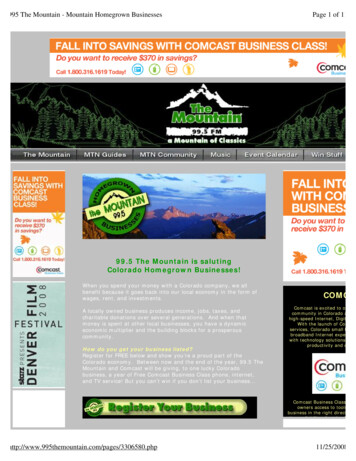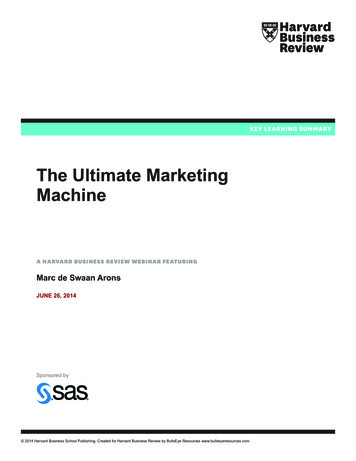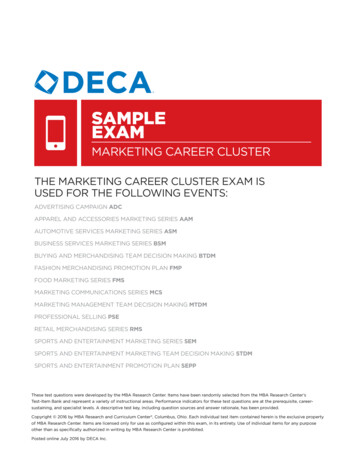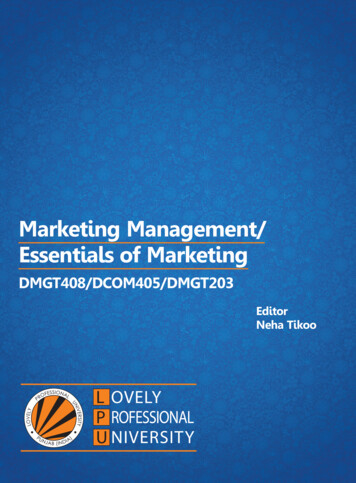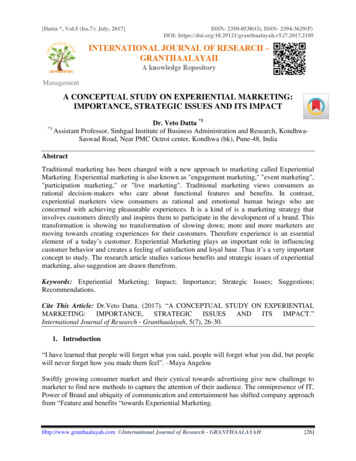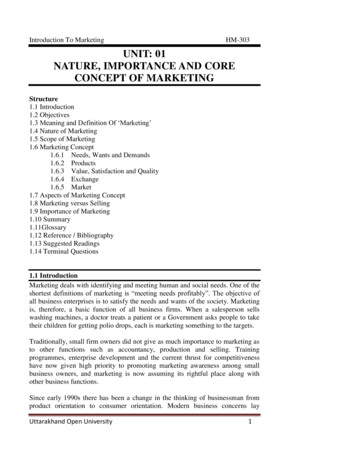
Transcription
Introduction To MarketingHM-303UNIT: 01NATURE, IMPORTANCE AND CORECONCEPT OF MARKETINGStructure1.1 Introduction1.2 Objectives1.3 Meaning and Definition Of ‗Marketing‘1.4 Nature of Marketing1.5 Scope of Marketing1.6 Marketing Concept1.6.1 Needs, Wants and Demands1.6.2 Products1.6.3 Value, Satisfaction and Quality1.6.4 Exchange1.6.5 Market1.7 Aspects of Marketing Concept1.8 Marketing versus Selling1.9 Importance of Marketing1.10 Summary1.11Glossary1.12 Reference / Bibliography1.13 Suggested Readings1.14 Terminal Questions1.1 IntroductionMarketing deals with identifying and meeting human and social needs. One of theshortest definitions of marketing is ―meeting needs profitably‖. The objective ofall business enterprises is to satisfy the needs and wants of the society. Marketingis, therefore, a basic function of all business firms. When a salesperson sellswashing machines, a doctor treats a patient or a Government asks people to taketheir children for getting polio drops, each is marketing something to the targets.Traditionally, small firm owners did not give as much importance to marketing asto other functions such as accountancy, production and selling. Trainingprogrammes, enterprise development and the current thrust for competitivenesshave now given high priority to promoting marketing awareness among smallbusiness owners, and marketing is now assuming its rightful place along withother business functions.Since early 1990s there has been a change in the thinking of businessman fromproduct orientation to consumer orientation. Modern business concerns layUttarakhand Open University1
Introduction To MarketingHM-303emphasis on ‗selling satisfaction‘ and not merely on selling products. Theactivities have to be coordinated so as to develop the marketing mix, whichprovides maximum satisfaction to the customers.That is why marketing research and product planning occupy an important role inmarketing. The other important functions of marketing include: buying andassembling, selling, standardization, packing, storing, transportation, promotion,pricing and risk bearing. Thus, the scope of marketing is very wide and no morerestricted to merely selling of products.1.2 ObjectivesAfter reading this unit you should be able to:1. appreciate the definitions of Marketing2. Understand the meaning and nature of ‗Marketing‘.3. Define the role of Marketing and discuss its core concepts.4. Understand the importance of Marketing1.3 Meaning and Definition of MarketingThe concept of marketing can be viewed from social and managerialperspectives. So Marketing is a social and managerial process by whichindividuals and groups obtain what they need and want through creating andexchanging products and value with others. At its simplest, marketing can bedefined as exchange transactions that take place between the buyer and the seller.Marketing is the management function, which organizes and directs all thosebusiness activities involved in assessing and converting customer purchasingpower into effective demand.The American Marketing Association offers the following formal definition:Marketing is an organizational function and a set of processes for creating,communicating and delivering value to customers and for managing customerrelationships in ways that benefit the organization and its stake holders.PhilipKotler defines marketing as ―a social process by which individuals and groupsobtain what they need and want through creating, offering and freely exchangingproducts and services of value with others‖. In essence, the marketing concept iscustomer orientation aimed at generating customer-satisfaction through integratedmarketing. Marketing may be narrowly defined as a process by which goods andservices are exchanged and the values determined in terms of money prices. Thatmeans marketing includes all those activities carried on to transfer the goods fromthe manufacturers or producers to the consumers.We shall be learning later in the lesson that marketing is more than a merephysical process of distributing goods and services. It is the process ofdiscovering and translating consumer wants into products and services. It beginsUttarakhand Open University2
Introduction To MarketingHM-303with the customer (by finding their needs) and ends with the customer (bysatisfying their needs). The components of marketing concept are as under:a. Satisfaction of Customers: In the modern era, the customer is thefocus of the organization. The organization should aim at producingthose goods and services, which will lead to satisfaction of customers.b. Integrated marketing: The functions of production, finance andmarketing should be integrated to satisfy the needs and expectations ofcustomers.c. Profitable sales volume: Marketing is successful only when it iscapable of maximizing profitable sales and achieves long-run customersatisfaction.So, ―Marketing is the performance of business activities that directs the flow ofgoods and services from producer to consumer or user.‖ This definition isundoubtedly an improvement on describing marketing as selling as it shows thatmarketing does encompass other activities besides selling.1.4 NATURE OF MARKETINGIs marketing based on a scientific method of inquiry, or is it essentially about anartistic process of creativity? Studies of marketing using the scientific frameworksof the natural sciences have found favour with followers of the positivistapproach. This holds that, from observations of the real world, it is possible todeduce models that are of general applicability. On this basis, models have beendeveloped to predict consumer behaviour, the profitability of retail locations, andprice–volume relationships, among many other phenomena.The great merit of the scientific approach is its claim to great objectivity, in thatpatterns and trends can be identified with greater confidence than if they werebased on casual observation. Many marketers have appreciated the value of thisscientific approach. Most major retailers rely heavily on models of retail locationbefore deciding where to locate their next outlet. Armed with trading statisticsfrom their existing network of stores and background information about theirlocations (e.g. the number of people living within 20 minutes‘ driving time,passing vehicle traffic per day, proximity to competitors, etc.), a regression modelcan be developed which shows the significance of each specified factor inexplaining sales success. To many people, marketing has no credibility if it doesnot adopt a rigorous, scientific method of inquiry. This method of inquiry impliesthat research should be carried out in a systematic manner and results should bereplicable: a model of buyer behavior should be able repeatedly to predictconsumers‘ actions correctly, based on a sound collection of data and analysis. Inthe scientific approach, data are assessed using tests of significance and modelsare accepted or rejected accordingly.Uttarakhand Open University3
Introduction To MarketingHM-303Marketing cannot possibly copy the natural sciences in its methodologies.Positivist approaches have been accused of seeking meaning from quantitativedata in a very subjective manner which is at variance with scientific principles(Brown, 1995). Experimental research in the natural sciences generally involvesclosed systems in which the researcher can hold all extraneous variables constant,thereby isolating the effects of changes in a variable that is of interest.For social sciences, experimental frameworks generally consist of complex socialsystems over which the researcher has no control: a researcher investigating theeffects of a price change in a product on demand from customers cannotrealistically hold constant all factors other than price. Indeed, it may be difficult toidentify just what the ‗other factors‘ are that should be controlled for in anexperiment, but they may typically include the price of competitors‘ products,consumer confidence levels, the effects of media reports about that productcategory, and changes in consumer fashions and Tastes, to name some of themore obvious. Contrast this with a physicist‘s laboratory experiment, where heat,light, humidity, pressure, and most other extraneous variables can be controlled,and the limitations of the scientific methodology in the social sciences becomeapparent. Marketers are essentially dealing with ‗open‘ systems, in contrast to the‗closed‘ systems that are more typical of the natural sciences. Post-positivistsplace greater emphasis on exploring in depth the meaning of individual casestudies than on seeking objectivity and reliability through large sample sizes.Many would argue that such inductive approaches are much more customerfocused, in that they allow marketers to see the world from consumers‘ overallperspective, rather than through the mediating device of a series of isolatedindicators. Post-positivist approaches to marketing hold that the ‗real‘ truth willnever emerge in a research framework that is constrained by the need tooperationalize variables in a watertight manner. In real-life marketing, the worldcannot be divided into clearly defined variables that are capable of objectivemeasurement. Constructs such as consumers‘ attitudes and motivation may bevery difficult to measure and model objectively. Furthermore, it is often theinteraction between various phenomena that is of interest to researchers, and itcan be very difficult to develop models that correspond to respondents‘ holisticperceptions of the world.There is another argument against the scientific approach to marketing, whichsees the process as essentially backward-looking. The scientific approach isrelatively good at making sense of historic trends, but less good at predicting whatwill happen following periods of turbulent change. Creativity combined with ascientific approach can be essential for innovation. The scientific approach tomarketing planning has a tendency to minimize risks, yet many major businesssuccesses have been based on entrepreneurs using their own judgment, inpreference to that of their professional advisers. Marketing has to be seen as acombination of art and science. Treating it excessively as an art can lead toUttarakhand Open University4
Introduction To MarketingHM-303decisions that are not sufficiently rigorous. Emphasizing the scientific approachcan lead a company to lose sight of the holistic perceptions of its customers.Successful firms seek to use scientific and creative approaches in acomplementary manner.1.5 Scope of MarketingThe scope of marketing can be understood in terms of functions that anentrepreneur has to perform. These include the following:a. Functions of exchange: which include buying and assemblingand selling?b. Functions of physical supply: include transportation, storage andwarehousingc. Functions of facilitation: Product Planning and Development,Marketing Research, Standardisation, Grading, Packaging, Branding,Sales Promotion, Financing.CHECK YOUR PROGRESS -1Q.1- What do you mean by ―Marketing‖ and distinguish it from mere ―Selling‖.Q.2- Define ―Nature of Marketing‖.Uttarakhand Open University5
Introduction To MarketingHM-3031.6 MARKETING CONCEPTThe marketing concept holds that the key to achieving organizational goalsconsists in determining the needs and wants of target markets and delivering thedesired satisfactions more effectively and efficiently than competitors. Undermarketing concept, the emphasis is on selling satisfaction and not merely on theselling a product. The objective of marketing is not the maximization of profitablesales volume, but profits through the satisfaction of customers. The consumer isthe pivot point and all marketing activities operate around this central point. It is,therefore, essential that the entrepreneurs identify the customers, establish arapport with them, identify their needs and deliver the goods and services thatwould meet their requirements. Customers provide payment to an organization inreturn for the delivery of goods and services and therefore form a focal point foran organization‘s marketing activity. Customers can be described by many terms,including client, passenger, subscriber, reader, guest, and student. Theterminology can imply something about the relationship between a company andits customers, so the term ‗patient‘ implies a caring relationship, ‗passenger‘implies an ongoing responsibility for the safety of the customer, and ‗client‘implies that the relationship is governed by a code of ethics (formal or informal).Needs, Wantsand tionshipsValue,Satisfactionand QualityFigure- Core Marketing ConceptsThe customer is generally understood to be the person who makes the decision topurchase a product, and/or who pays for it. In fact, products are often bought byone person for consumption by another, therefore the customer and consumerneed not be the same person. For example, colleges must market themselves notonly to prospective students, but also to their parents, careers counsellors, localemployers, and government funding agencies. In these circumstances it can bedifficult to identify on whom an organization‘s marketing effort should befocused.Uttarakhand Open University6
Introduction To MarketingHM-303For many public services, it is society as a whole, and not just the immediatecustomer, that benefits from an individual‘s consumption. In the case of healthservices, society can benefit from having a fit and healthy population in which therisk of contracting a contagious disease is minimized. Different customers withina market have different needs which they seek to satisfy. To be fully marketingoriented, a company would have to adapt its offering to meet the needs of eachindividual. In fact, very few firms can justify aiming to meet the needs of eachspecific individual; instead, they target their product at a clearly defined group insociety and position their product so that it meets the needs of that group. Thesesubgroups are often referred to as ‗segments‘.1.6.1 Needs, Wants and DemandsThe most basic concept underlying marketing is that of human needs. Consumersare motivated by their desire to satisfy complex needs, and these should be thestarting point for all marketing activity. We no longer live in a society in whichthe main motivation of individuals is to satisfy the basic needs for food and drink.Maslow (1943) recognized that, once individuals have satisfied basicphysiological needs, they may be motivated by higher-order social and selffulfillment needs. In order of importance, they are physiological needs, safetyneeds, social needs, esteem needs and self-actualization needs. People will try tosatisfy their most important needs first. When a person succeeds in satisfying animportant need, he or she will then try to satisfy the next -most-important need.‗Need‘ refers to something that is deep-rooted in an individual‘s personality. Howindividuals go about satisfying that need will be conditioned by the cultural valuesof the society to which they belong. In some cultures the need for self-fulfillmentmay be satisfied by a religious penance, while other societies may seek it througha development of their creative talents.Self -actualization Needs(Self-development and Realization)Esteem Needs(Self-esteem, Recognition, Status)Social Needs(Sense of belonging, love)Security Needs(Security, Protection)Physiological Needs(Food, Water, Shelter)Figure: Maslow‟s Hierarchy of NeedsUttarakhand Open University7
Introduction To MarketingHM-303It is useful to make a distinction between needs and wants. Wants are culturallyconditioned by the society in which an individual lives. Wants subsequentlybecome effective demand for a product where there is both willingness and anability to pay for the product. Marketers are continually seeking to learn moreabout underlying needs which may eventually manifest themselves as demand inthe form of people actually being willing to pay money for its products.It must not be forgotten that commercial buyers of goods and services also havecomplex needs which they seek to satisfy when buying on behalf of theirorganizations. Greater complexity occurs where the economic needs of theorganization may not be entirely the same as the personal needs of individualswithin the organization.People have almost unlimited wants, but limited resources. They choose productsthat produce the most satisfaction for their money. When backed by buyingpower, wants become demands. Consumers view products as bundles of benefitsand choose those that give then the best bundle for their money. People choosethe product whose benefits add up to the most satisfaction, given their wants andresources.1.6.2 ProductPeople satisfy their needs and wants with products. A product is anything that canbe offered to satisfy a need or want. The concept of product is not limited tophysical objects. Anything capable of satisfying a need can be called a product.More broadly defined, products include experiences, persons, places,organizations, information, and ideas. Thus, the term product includes much morethan just physical goods or services. Consumers decide which events toexperience, which tourist‘s destinations to visit, which hotels to stay in, and whichrestaurants to patronize. To the consumer these are all products. One of the mostinteresting areas of marketing is product planning and development.1.6.3 Value, Satisfaction and QualityFor customers, value is represented by the ratio of perceived benefits to pricepaid. Customers will evaluate benefits according to the extent to which a productallows their needs to be satisfied. Customers also evaluate how well a product‘sbenefits add to their own well-being as compared with the benefits provided bycompetitors‘ offerings:Customer perceived value Benefits deriving from a product/ Cost of acquiringthe productConsumers often place a value on a product offer that is quite different from thevalue presumed by the supplier. Business organizations succeed by adding valueat a faster rate than they add to their own production costs. Value can be added byUttarakhand Open University8
Introduction To MarketingHM-303better specifying a product offer in accordance with customers‘ expectations, forexample by providing the reassurance of effective after-sales service.Estimating customers‘ assessment of value is not easy for marketers.Segmentation is crucial to this exercise, as some groups of buyers are likely toplace significantly higher values on the firm‘s goods than others. If the price of agood is set too high, no sale may take place, or at least only a one-off sale whichmay be regarded by the buyer as a ‗rip-off‘. If the price is set too low, the suppliermay achieve high levels of sales, but fail to make any profit because the price istoo low to cover its costs. Firms need to understand not just what constitutes valuetoday, but how customers‘ perceptions of value will change over time.Customer satisfaction depends on a product‘s perceived performance in deliveringvalue relative to a buyer‘s expectations. If the product‘s performance falls short ofthe customer‘s expectations, the buyer is dissatisfied. If performance matchesexpectations, the buyer is satisfied. If performance exceeds expectations, thebuyer is delighted. Smart companies aim to delight customers by promising onlywhat they can deliver, then delivering more than they promise.Customer expectations are based on past buying experiences, the opinions offriends and market information. Marketers must be careful to set the right level ofexpectations. If they set expectations too low, they may satisfy those who buy, butfail to attract new customers. If they raise expectations too high, buyers will bedisappointed.Still most of today‘s most successful companies are raisingexpectations- and delivering performance to match. These companies aim highbecause they know that customers who are merely satisfied will find it easy toswitch suppliers when a better offer comes along. Thus,customerdelightcreates an emotional tie to a product or services, not just a rational preference, andthis creates high customer loyalty. Highly satisfied customers make repeatpurchases, are less price sensitive, remain customers longer, and talk favorably toothers about the company and its products. Quality has a direct impact onproduct or service performance. Thus, it is closely linked to customer value andsatisfaction. In the narrowest sense, quality can be defined as ―freedom fromdefects‖; however, most customer centered companies go beyond this narrowdefinition of quality. Instead, quality is defined in terms of customer satisfaction.1.6.4 ExchangeSocieties have different ways in which they arrange for goods and services to beacquired. In some less developed societies, hunting for food, or begging, may be anorm. In centrally planned economies goods and services may be allocated toindividuals and firms by government planners. In modern market-basedeconomies, goods and services are acquired on the basis of exchange. Exchangeimplies that one party makes some sacrifice to another party in return forreceiving something it values; the other party similarly makes a sacrifice andreceives something that it values. Of course, the sacrifices and valuations of goodsUttarakhand Open University9
Introduction To MarketingHM-303received and given up are essentially based on personal opinion and preferences,so there is no objective way of defining: what is a ‗fair‘ exchange, other thanobserving that both parties are happy with the outcomes. In market-basedeconomies there is a presumption that each party can decide whether or not toenter into an exchange with the other. Each party is also free to choose between anumbers of alternative potential partners. Exchange usually takes the form of aproduct being exchanged for money, although the bartering of goods and servicesis still common in some trading systems.Can the concept of exchange be generalized to cover the provision of publicservices? Some have argued that the payment of taxes to the government in returnfor the provision of public services is a form of social marketing exchange.Within marketing frameworks, the problem with this approach to exchange is thatit can be difficult to identify what sovereignty consumers of government serviceshave in determining which exchanges they should engage in. A single exchangeshould not be seen in isolation from the preceding and expected subsequentexchanges between parties. Marketers are increasingly focusing on analyzingongoing exchange relationships, rather than one-off and isolated exchanges.1.6.5 MarketsThe term ‗market‘ has traditionally been used to describe a place where buyersand sellers gather to exchange goods and services (for example, a fruit andvegetable market or a stock market).Economists define a market in terms of a more abstract concept of interactionbetween buyers and sellers, so that the ‗cheese market‘ is defined in terms of allbuyers and sellers of cheese in the country. Markets are defined with reference tospace and time, so marketers may talk about sales of a particular type of cheese inthe north-west region for a specified period of time. Various measures of themarket are commonly used, including sales volumes, sales values, growth rate,and level of competitiveness.1.7 ASPECTS OF MARKETING CONCEPTThe important aspects of marketing concept are: Creation of demand: Marketing tries to create demand through variousmeans. The producers first ascertain what the customers want and then producegoods according to the needs of the customers. There is a systematic effort tosell goods and services according to the needs of the customers. Customer Orientation: Marketing involves undertaking a range of businessactivities directed at the creation of customer satisfying products and services.Uttarakhand Open University10
Introduction To MarketingHM-303 Integrated Marketing: The customer orientation alone is not enough on thepart of management. To be effective must be backed by an appropriate set upwithin the country. The responsibility of marketing department is to ensurecoordination of the various departments of the company i.e., finance, purchase,research and development. Profitable sales volume through customer satisfaction: Marketing tries torealize long-term goals of profitability, growth and stability through satisfyingcustomers‘ wants. All the basic activities of a company are planned to meet thewants of customers and still making reasonable profits. Modern marketing thusbegins with the customer and ends with the customer.1.8 MARKETING VERSUS SELLINGThe basic difference between marketing and selling lies in the attitude towardsbusiness. The selling concept takes an inside-out perspective. It starts with thefactory, focuses on the company‘s existing products, and calls for heavy sellingand promoting to produce profitable sales. The marketing concept takes anoutside-in perspective. It starts with a well-defined market, focuses on customerneeds, coordinates all the activities that will affect customers, and producesprofits through creating customer satisfaction.Marketing vs. SellingMarketing Focuses on Customer’s needs. Customer enjoys supreme importance. Converting customer’s needs intoproduct. Profits through customer satisfaction. Emphasis is given on product planningand development to match products withthe market. Integrated approach to marketing ispracticed. The principle of caveat vendor (let theseller beware) is followed.Selling Focuses on seller’s needs. Product enjoys supreme importance. Converting product into cash. Profits through sales volume. Emphasis is placed on sale ofproducts already produced. Fragmented approach to selling ispracticed. The principle of caveat emptor (let thebuyer beware) is followed.1.9 IMPORTANCE OF MARKETINGSince marketing is consumer oriented, it has a positive impact on the businessfirms. It enables the entrepreneurs to improve the quality of their goods andservices. Marketing helps in improving the standard of living of the people byUttarakhand Open University11
Introduction To MarketingHM-303offering a wide variety of goods and services with freedom of choice, and bytreating the customer as the most important person.Marketing generates employment both in production and in distribution areas.Since a business firm generates revenue and earns profits by carrying outmarketing functions, it will engage in exploiting more and more economicresources of the country to earn more profits.A large scale business can have its own formal marketing network, mediacampaigns, and sales force, but a small unit may have to depend totally onpersonal efforts and resources, making it informal and flexible. Marketing makesor breaks a small enterprise. An enterprise grows, stagnates, or perishes with thesuccess or failure, as the case may be, of marketing. ―Nirma‖ is an appropriateexample of the success of small scale enterprise.CHECK YOU PROGRESS - 2Q.1- What do you mean by ―Marketing Concept‖.Q.2- ―Marketing and Sales are related concepts‖. Discuss.1.10 SUMMARYThis unit has introduced the meaning and nature of marketing that act as buildingblocks for more detailed discussion in the following units. Having read this unit,Uttarakhand Open University12
Introduction To MarketingHM-303you should be aware of the wide definition of marketing and core concept ofmarketing. Today‘s successful companies-whether small or large, share a goal ofcustomer satisfaction and are committed to marketing. The marketing comprisesmany activities- product development, pricing, personal selling, effectivechannels of distribution, all aimed to achieve profits through customersatisfaction.Tobe successful in service industry, all the players will have to bestrongly market focused. They need to identify market segments since buyers arenumerous, widely scattered and different in their needs and preferences. Theservice product is highly perishable since the supply of services cannot be storedfor future use; therefore marketing in service industry is different from marketingof manufactured goods. The service product is developed and other tools ofmarketing mix are designed to formulate prices, advertising and distributionchannels to reach the target market efficiently. Market research helps to designand formulate such a strategy.1.11 GLOSSARY Attitude: A person‘s consistently favourable or unfavorable evaluations,feelings, and tendencies toward an object or idea. Customer satisfaction: The extent to which a product‘s perceivedperformance matches a buyer‘s expectations. Discount: A straight reduction in price on purchases during a stated period oftime. Human Need: A state of felt deprivation in a person. Human Want: The form that a human need takes when shaped by cultureand individual personality. Marketing: A social and managerial process by which people and groupsobtain what they need and want through creating and exchanging productsand values with others. Marketing Concepts: The marketing management philosophy that holdsthat achieving organizational goals depends on determining the needs andwants of target markets and delivering desired satisfactions more effectivelyand efficiently than competitors. Marketing Management: The analysis, planning, implementation andcontrol of programs designed to create, build and maintain beneficialexchanges with target buyers for the purpose of achieving organizationalobjectives.Uttarakhand Open University13
Introduction To MarketingHM-303 Product: Anything that can be offered to a market for attention, acquisition,use or consumption that might satisfy want or need. It includes physicalobjects, services, persons, places, organizations and ideas. Product Positioning: The way the product is defined by co
Define the role of Marketing and discuss its core concepts. 4. Understand the importance of Marketing 1.3 Meaning and Definition of Marketing The concept of marketing can be viewed from social and managerial perspectives. So Marketing is a social and managerial process by which individu


